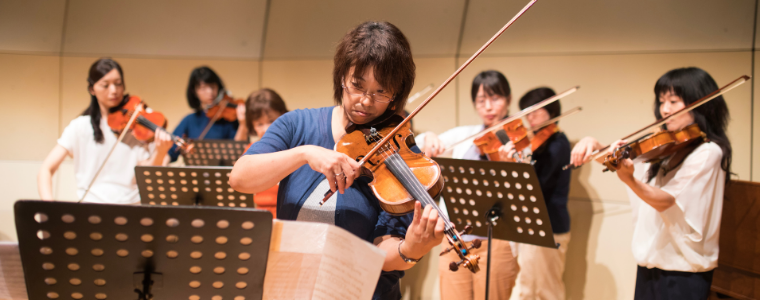Adult Learning Groups for Violin, Part 2: How to Form Your Own and Get Members

5 Steps for Forming a Learning Group for Adult Violinists
You may be familiar with the adage, “if you build it, they will come.” With a little vision and initiation on your part, you’ll be able to gather two or three interested violinists quicker than you can say “scales and arpeggios.”
Once formed, groups like these typically gain momentum and membership through word-of-mouth. Who knows? You may even find yourself with a lovely little quartet, ensemble, or community orchestra in the making.
(Editors' Note: We recently posted an article for finding existing adult learning groups for violin. If, however, you were unable to find a group that met your needs, connect with your inner visionary and take the steps necessary to form a group of your own.)
1. Post Flyers at Local Music Schools and Instrument Shops
People who play instruments, particularly beginners or fresh intermediate-level students, are likely to be interacting with their local music schools and instrument shops to learn more about the craft.
If you aren’t affiliated with a music school or violin teacher this might be a good time to take some lessons. Many schools offer group lessons for adults, which can be an instant connection to others who would like to take their learning and practice a step further by joining a practice or playing group.
Whether or not you're a student or customer, ask permission to post flyers at these locations, or to create posts for their website message forums. Both are smart ways to begin the search for like-minded newbies. These schools’ instructors and staff may be inspired by your interest and willingness to help by reaching out to their students and customers on your behalf.
2. Post Your Request on Social Media Platforms
Social media platforms such as Craigslist, NextDoor, MeetUp, and Facebook are powerful networking tools for people who want to connect with others in their communities. Create posts with your intentions. You never know how many others are hoping for the same types of groups to form, but don’t take the initiative to form one.
Currently, we’re in the midst of a pandemic. While meeting indoors may be potential down the road, keep in mind that plenty of musical groups are choosing to meet safely in outdoor locations, such as parks, beaches, large backyards, and other community-based spaces. Be upfront about your commitment to safety and current pandemic guidelines so prospective members feel more comfortable about joining the group.
3. Connect With Local Orchestra Leaders
Do you have a local community orchestra? Contact the conductor and check in with them about your desire to form an adult learning group for violin. You may be surprised with an invitation to join the orchestra as some smaller orchestras welcome new musicians into the fold.
If not, they might be willing instead to make your wishes known to the orchestra group. They may even allow you to share information on the orchestra website, social media pages, or to post a flyer at their rehearsal location.
4. Consider Expanding the Group to Other String Musicians
Your first goal may be to form an adult violin group, and that could happen quicker than you think. However, there is something to be said about practicing and playing in an ensemble format, including other string players in the mix.
Even though you’re all beginners, there are many things you have in common with beginning and intermediate players. Among those are the types and levels of musical scores you’re learning. This gives you all the opportunity to practice and play music with multiple parts. All of which is both fun and highly satisfying.
5. Make the Group Enticing to a Variety of Playing Levels
Your original intention to start an adult learning group for violinists is sound. It’s nice to play with people who are at your same level because shared ability and competence provides a safer learning (and error) space for all of you. That said, you may find better success by broadening the horizons and opening the group up to intermediate and experienced players to challenge yourself.
First and foremost, playing with those who are ahead of you is a great way to improve technique and accelerate your own learning. Second, there are plenty of ways to structure the group to meet everyone’s basic learning needs. For example, you can schedule a two- or three-hour block for the group. Then, make it known that the first hour is “beginner’s hour,” and that the second and third hours will be dedicated to jamming and learning new songs for players of all levels.
Good Luck!
We applaud your commitment to forming an adult learning group for violin. Taking these five steps is guaranteed to help you find “your people” and to forge lifelong ties with other string-loving musicians in your community. Let the playing begin!

